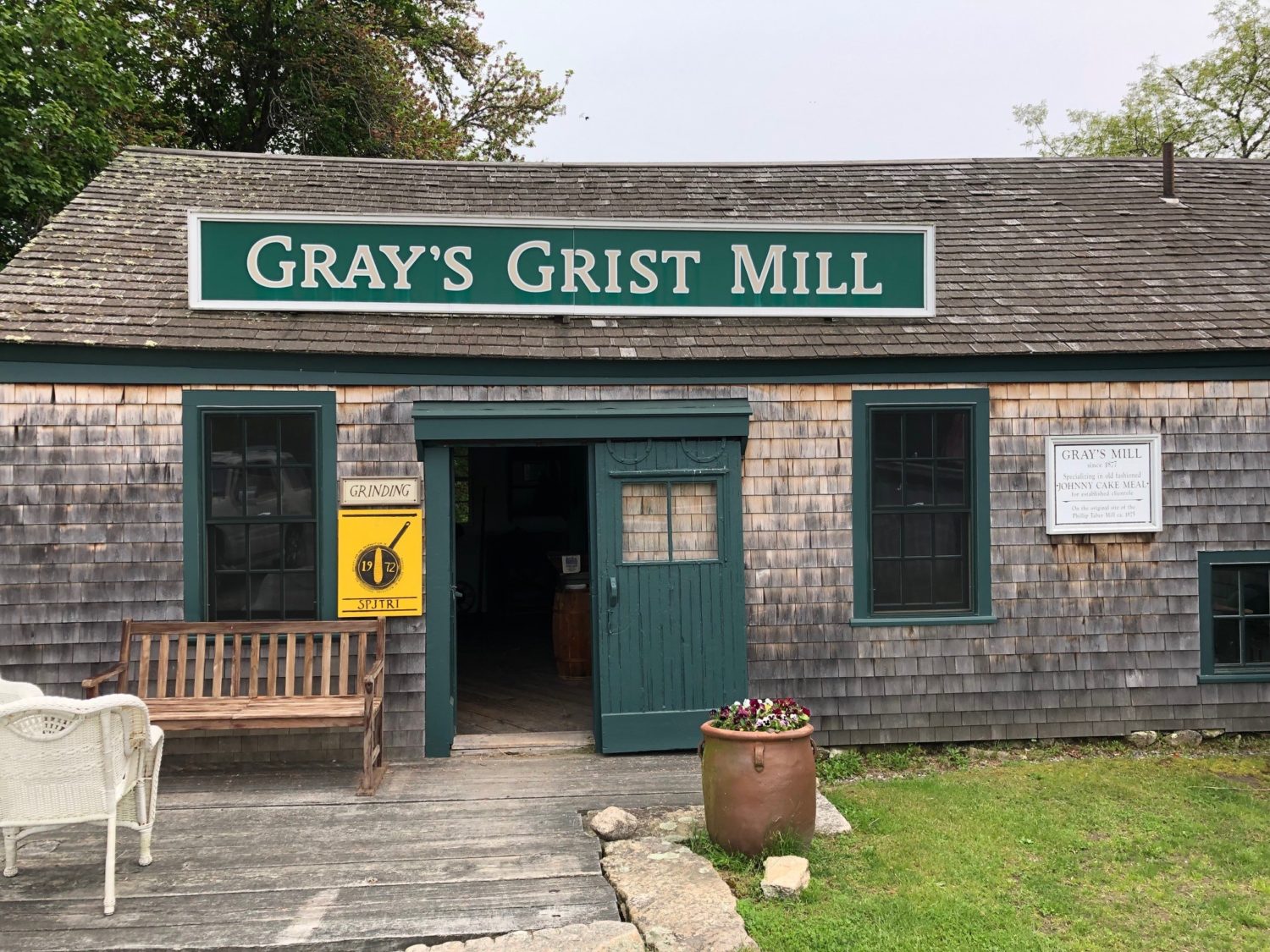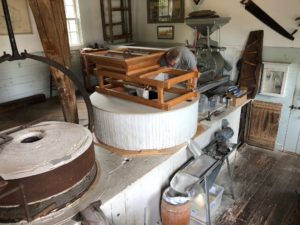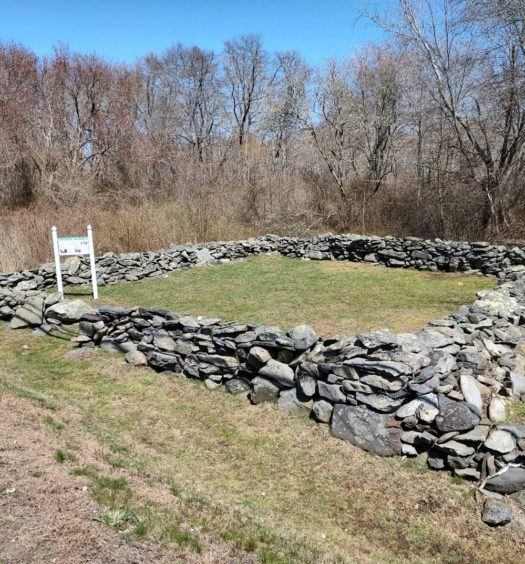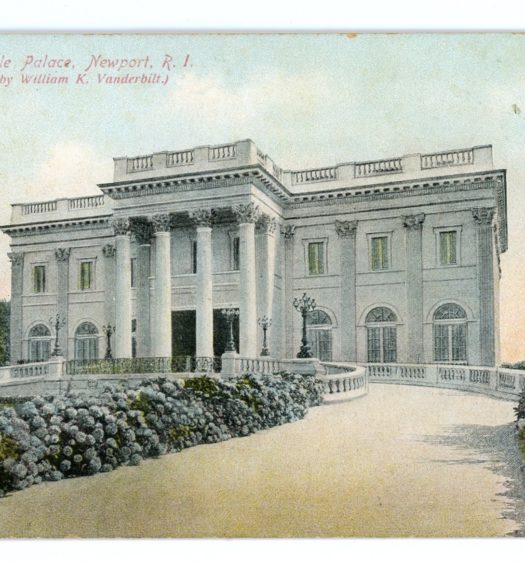As you know, the Online Review of Rhode Island History (aka smallstatebighistory.com) focuses on Rhode Island history. We don’t like going over a state line — particularly now during a pandemic.
However, we are making an exception for Gray’s Grist Mill, located at 638 Adamsville Road in Westport, Massachusetts. If you stopped at Tiverton Four Corners for a cookie at Provender’s and an ice cream across the street, then drove about two miles to the west on Route 179, you would arrive at Adamsville and a small pond that is in Rhode Island. If you threw a stone over the pond, you would come close to hitting Gray’s Grist Mill. In addition, the mill’s post office address is in Adamsville. And the mill advertises that it sells “the famous Rhode Island Jonnycake meal,” made from Rhode Island flint corn.

The exterior of Gray’s Grist Mill, just over the border from Adamsville, Rhode Island, in Westport, Massachusetts (Christian McBurney)
The mill’s operator, George Whitely, has close connections to working grist mills in Rhode Island—Kenyon Grist Mill at Usquepaugh, Samuel E. Perry Grist Mill at Perryville, and the Hammond Gristmill at the Gilbert Stuart Birthplace in Saunderstown. And George gives tours of the Robert Sherman Windmill at Prescott Farm in Portsmouth and Middletown for the Newport Restoration Society. So we are making Gray’s Grist Mill an honorary Rhode Island location.
Gray’s Grist Mill is small, but charming. When I walked in on a Saturday afternoon about 1:30 p.m. for an unannounced visit, George Whitley, was busy running the mill, turning Narragansett corn into fine Jonnycake meal. Gray’s Mill is one of the only mills in New England that uses solely Indian Flint Corn. By using solely Indian corn, Gray’s Mill can call its product Jonnycake corn meal, with no letter “h” in the name. If a grist mill does not use Indian corn, then it must add the “h” to the name—Johnnycake corn meal.
The word “johnnycake” is probably a variation of the word “journey cake,” a term used hundreds of years ago to refer to a cake packed for a long-distance journey.
George explained to me that there are three types of Indian Flint Corn in southern New England: Narragansett, Wampanoag, and Pequot. Narragansett, or Rhode Island, corn is grown in southern Rhode Island, the former home and hunting grounds of the Narragansett tribe. It harkens back to the same type of corn eaten by the Narragansett sachem Miantonomi and Roger Williams. “It was the original corn grown in this area,” George says. He notes that the southern coast of Rhode Island has soft gentle breezes that impart a distinctive rich flavor. “The farther west you go the thicker” the cornmeal batter tends to get, George adds.
According to Rhode Island cookbook author Barbara Sherman Stetson, the Newport style of johnnycakes was very thin and lacy, but the South County area made them thicker. Block Islanders added egg to theirs, she said.
George informed me that the corn has to sit and dry for six months before it can be ground. He noted that because the yield of farms growing Indian corn is low, little of it is grown today. A seed bank at the University of Rhode Island Agricultural School preserved the seed for the Indian Flint Corn. In recent years, most of the Indian corn in Rhode Island was grown by Harry Records, who had a farm off Ten Rod Road (Route 102) in Exeter. Harry passed away last year, and Philip Curry now continues the tradition of growing Indian Flint Corn at Harry’s former farm.
Gray’s Grist Mill is one of the oldest continually running grist mills in New England. A mill has operated from the location since 1717, and probably as far back as 1675.
In 1981, Ralph Guild, a New York City businessman who spent summers with his family in Westport, purchased the mill from John Hart. Hart had operated the mill from 1939 to 1980. Hart agreed to sell to Ralph Guild, but with one condition—the mill must continue to be run as a working will.
Ralph Guild has been a terrific caretaker of the mill ever since. “I think it’s important to keep this link with the past,” he said. It has not always been easy to find someone knowledgeable about milling and willing to do it. At one point, the mill was closed from 1997 to 2002, until a new miller was found. Ralph Guild is now over 90 years old.
Before the mill can grind the corn, the corn is husked and shelled. George pointed to huskers and shelling machines nearby. The shelled corn is then poured into a wooden hopper that can hold three bushels of corn. A vertical rod called the “damsel” shakes the grain steadily downward. The corn kernels then drop through the “shoe” into the eye of the mill stone.
The massive 15-inch thick millstones are disk shaped and weigh a total of 1 1/2 tons. One stone grinds the corn and another is used to grind grains for other flours. Corn is ground with granite stone only. The top stone, called the “runner stone,” turns and creates friction against the lower “bed” or “nether” stone, which never turns. This grinding action reduces the corn to meal. The two stones cut across each other with a scissors action and push the grain toward the outside edges of the stones. At the center, the grain gets cracked, and then at the outer perimeter of the stones, the grain is ground into fine flour.

Ground corn is sold in these Johnny Cake bags next door to the Grist Mill in the fine coffee and pastry shop (Christian McBurney)
The ground meal then comes out of the grain spout, and a mesh screen sifts out the coarser pieces into the chiff bin. The bins of the fine ground meal are hauled into a bagging room, where it is scooped onto a scales and bagged into cloth or other types of bags.
George Whitely says the stones can grind about 60 pounds of corn per hour. He typically grinds about 100 to 150 pounds of corn each day that he operates the mill.
Of course, the grist mill for centuries was run by water power from the nearby pond. After the 1938 hurricane knocked out the turbines that were run by the rushing water, the stone was turned by a gasoline motor. Today, it is powered by an electric motor.
One of the most remarkable aspects of old grist mills is the wooden crane that lifts the 1-and-1/2-ton runner stone when it needs to be cleaned, sharpened, or repaired. George, who handles the crane solo, can tell you about some accidents that have occurred. Fortunately, no one has been injured.
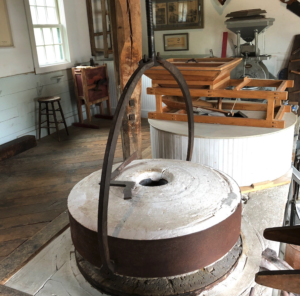
Another inside view showing the two mill stones, one in use and the closest one in reserve (Christian McBurney)
The reader is encouraged to visit Gray’s Grist Mill. It is best to call ahead so that you can see George Whitely in action, grinding the corn. He is also happy to explain the process to the uninitiated. He is clearly one of the experts in this field and is generous in passing along his knowledge. So for a visit, call ahead at 508-636-6075 or email him at info@graygristmill.com.
Attached to the mill is a charming bakery and coffee shop, where you can also purchase the Rhode Island Jonnycake meal ground next door. Pancake mix is also ground at the mill and sold at the store. Gray’s Grist Mill is also selling its products in some local restaurants and in Dave’s Market in North Kingstown.
[Banner Image: The exterior of Gray’s Grist Mill, just over the border from Adamsville, Rhode Island, in Westport, Massachusetts (Christian McBurney)]
Sources:
Information used in this article was obtained from the following sources: Christian McBurney interview with George Whitely, June 1, 2019; a Gray’s Grist Mill flier and the mill’s website at www.graygristmill.com. An excellent video of the grinding operation can be seen on the website. See also Westport Shorelines newspaper articles at the Mill, including one, dated July 19, 2002.

